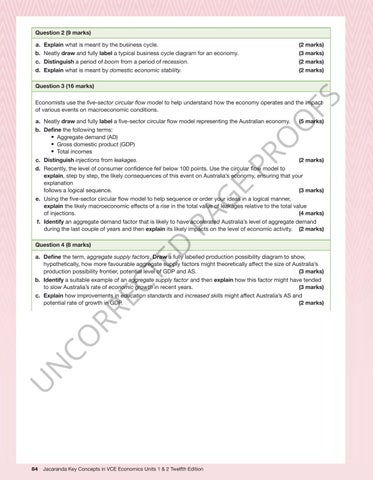“c04EconomicActivity_PrintPDF” — 2022/5/28 — 13:00 — page 84 — #84
Question 2 (9 marks) a. b. c. d.
Explain what is meant by the business cycle. Neatly draw and fully label a typical business cycle diagram for an economy. Distinguish a period of boom from a period of recession. Explain what is meant by domestic economic stability.
(2 marks) (3 marks) (2 marks) (2 marks)
FS
Question 3 (16 marks) Economists use the five-sector circular flow model to help understand how the economy operates and the impact of various events on macroeconomic conditions.
Question 4 (8 marks)
D
PA
G
E
PR
O
O
a. Neatly draw and fully label a five-sector circular flow model representing the Australian economy. (5 marks) b. Define the following terms: • Aggregate demand (AD) • Gross domestic product (GDP) • Total incomes c. Distinguish injections from leakages. (2 marks) d. Recently, the level of consumer confidence fell below 100 points. Use the circular flow model to explain, step by step, the likely consequences of this event on Australia’s economy, ensuring that your explanation follows a logical sequence. (3 marks) e. Using the five-sector circular flow model to help sequence or order your ideas in a logical manner, explain the likely macroeconomic effects of a rise in the total value of leakages relative to the total value of injections. (4 marks) f. Identify an aggregate demand factor that is likely to have accelerated Australia’s level of aggregate demand during the last couple of years and then explain its likely impacts on the level of economic activity. (2 marks)
U
N
CO RR EC
TE
a. Define the term, aggregate supply factors. Draw a fully labelled production possibility diagram to show, hypothetically, how more favourable aggregate supply factors might theoretically affect the size of Australia’s production possibility frontier, potential level of GDP and AS. (3 marks) b. Identify a suitable example of an aggregate supply factor and then explain how this factor might have tended to slow Australia’s rate of economic growth in recent years. (3 marks) c. Explain how improvements in education standards and increased skills might affect Australia’s AS and potential rate of growth in GDP. (2 marks)
84
Jacaranda Key Concepts in VCE Economics Units 1 & 2 Twelfth Edition





















































